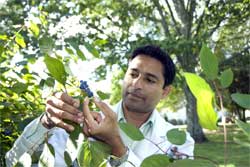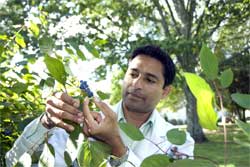 Playing role in returning College of Pharmacy to prominence as plant natural products research center
Playing role in returning College of Pharmacy to prominence as plant natural products research center
KINGSTON, R.I. – September 25, 2008 – He’s been here less than a year, but Navindra Seeram is already putting the University of Rhode Island’s College of Pharmacy back in the spotlight for its research on plants, including the health benefits of medicinal foods such as fruits and vegetables.
The assistant professor of pharmacy has been recently selected the editor of the Clinical Pharmacognosy Series, a new CRC Press (Taylor and Francis) book series that will delve into uses and benefits of natural products in clinical pharmacy practice. “There is much need for a book series targeting the clinical study of natural products, and I started working with the publishers on this project about four years ago”.
The Clinical Pharmacognosy Series will address the fusion of classical pharmacognosy with modern chemical and biological approaches, along with their applications in clinical settings. Each volume in the series will run about 500 pages. The scientific, peer-reviewed books in the series will address issues such as infectious diseases, cancer, cardiovascular diseases, obesity, diabetes, aging, and “we’ll add more as the scientific evidence grows,” Seeram said.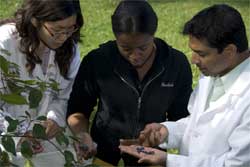
In addition Seeram has been featured in the April 2008 edition of a popular trade magazine, Nutritional Outlook, in a story titled, “Superfoods Help Heart Health,” and the magazine’s September issue in a story about consuming “Superfruits” like pomegranate to improve joint health. He was also quoted in the January 2008 edition of Oncology News International in a story titled “Black raspberries show promise in human trials.”
Seeram, who was hired last January by the College of Pharmacy, said he responds to many media and publishing requests to get the word out about the importance of medicinal foods, particularly berries, in enhancing human health.
“It’s not only important to do good science, but you also have to tell the story,” Seeram said. “As scientists, we are obligated to discuss our research in a way that the mass audience can understand. However, we need to communicate the science responsibly. I take time out of my busy schedule to talk with the popular press because the average person is not reading about our work in scholarly journals.”
Seeram also wants to play a role in restoring the College to its prominence as a center of research in medicinal plant research, a hallmark of the College from the 1950s.
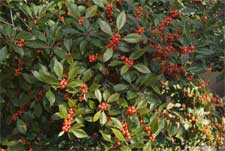 Since his arrival, Seeram has established a research partnership with City of Hope Hospital outside of Los Angeles, which is an independent biomedical research, treatment and education center dedicated to preventing and curing cancer and other life-threatening diseases. It is one of only 40 National Cancer Institute-designated Comprehensive Cancer Centers nationwide and a founding member of the National Comprehensive Cancer Network.
Since his arrival, Seeram has established a research partnership with City of Hope Hospital outside of Los Angeles, which is an independent biomedical research, treatment and education center dedicated to preventing and curing cancer and other life-threatening diseases. It is one of only 40 National Cancer Institute-designated Comprehensive Cancer Centers nationwide and a founding member of the National Comprehensive Cancer Network.
In addition, Seeram wants to make the University a regular home for national conferences on natural products research. In the past, the University hosted two annual meetings of the prestigious American Society of Pharmacognosy, and three of the College’s faculty members, the late Heber Youngken Jr., the first dean of the pharmacy college, Yuzuru Shimizu, professor emeritus of pharmacy and Roy Okuda, a former URI professor now at San Diego State University, served at various times as the organization’s presidents.
Focusing on the medicinal properties of berries and other fruits and vegetables comes as nations around the world deal with increasing rates of obesity, diabetes, cancer, heart disease and other life-threatening illnesses.
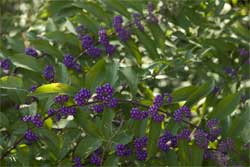 “At URI, and other laboratories around the world, we are interested in compounds that make the blueberry blue and the strawberry red,” Seeram said. “Because plants are rooted and can’t escape the effects of the sun, dangers of predators and other threats, they have developed bioactive compounds such as pigments that we have found are natural antioxidants,” Seeram said. “Colors in plants protect them from solar irradiation. These are the anti-cancer agents we are paying attention to.
“At URI, and other laboratories around the world, we are interested in compounds that make the blueberry blue and the strawberry red,” Seeram said. “Because plants are rooted and can’t escape the effects of the sun, dangers of predators and other threats, they have developed bioactive compounds such as pigments that we have found are natural antioxidants,” Seeram said. “Colors in plants protect them from solar irradiation. These are the anti-cancer agents we are paying attention to.
“So, go ahead and snack on those strawberries, raspberries or blueberries because they taste good, but you are also doing yourself a healthy favor,” Seeram said.
“In tropical Africa, 50,000 years ago, humans walked all over the place and ate more than 800 varieties of foods that provided them with more than 25,000 phytochemicals (beneficial plant compounds) that kept them healthy. Today, we don’t walk anymore and we eat loads of processed foods,” the researcher said. “Fewer than 25 percent of Americans eat five servings of fruits and vegetables a day and the negative health effects can be seen everywhere.”
To call attention to the bounty of berry fruits all around us, Seeram and his team of researchers and students have been collecting native New England berry fruits on campus and at other sites. “We are looking at native berries that have never been researched,” he said.
Among some of the varieties found on campus are dogwood berries, huckleberries, blueberries, American beautyberry, and not far away at the coast, the beach plum.
Focusing on such fruits is important, Seeram said, because the nutraceutical and medicinal plant industry will become a $600 billion business by 2010. Such growth is also important for pharmacists and the reason why he teaches a course in medicinal plants to the doctor of pharmacy students.
“Pharmacies experienced an increase of 45 percent in sales of herbal supplements in the 1990s and it is estimated that almost 19 percent of persons using prescription medications also use herbal products,” Seeram said. “The modern-day pharmacist is constantly challenged to counsel consumers, patients, and also other health care professionals, on various aspects pertaining to natural products.”
The professor said much of this growth is arising out of America’s changing demographics related to immigrants from Southeast Asia and other eastern cultures with long traditions of using natural products to treat and prevent illness.
He said many of the compounds he is studying prevent disease. “Prevention is always better than the cure, because once you are involved with the cure, you already have the disease,” he said. “Two-thirds of our health is out of our control because of genetic and environmental influences, but one-third is our control through our choices relating to diet and exercise.”
Pictured above
IN THE WILD BERRY PATCH: Navindra Seeram, URI assistant professor of pharmacy, examines some dogwood berries that are native to the Kingston Campus. URI Department of Communications and Marketing photo by Nora Lewis.
(Orange-red berries)Viburnum
(Lavender berries)American beautyberry
GATHERING DOGWOOD BERRIES: Navindra Seeram, URI assistant professor of pharmacy, left, examines some dogwood berries he and Dinorah Jean-Gilles, center, a URI pharmacy graduate student, and Liya Li, a post-doctoral fellow, picked on the Kingston Campus. Seeram’s research team is the first to examine the potential health benefits of the dogwood berry, which is a native Rhode Island berry. URI Department of Communications and Marketing photo by Nora Lewis.

